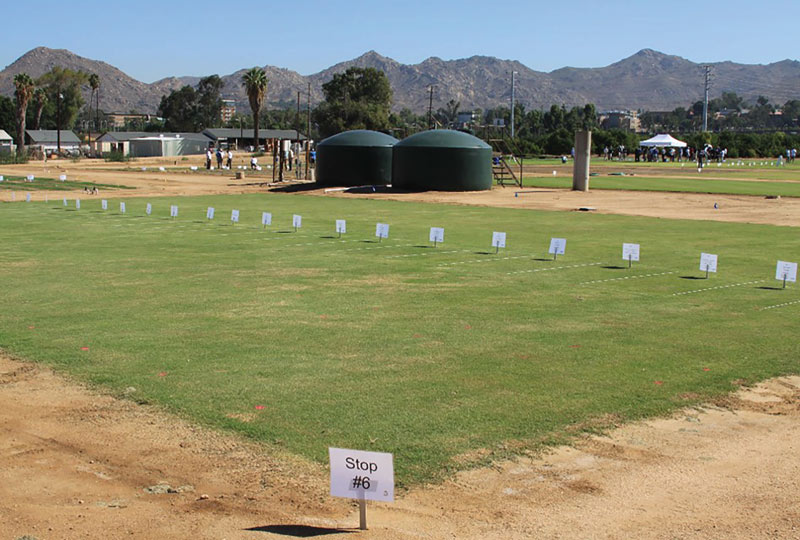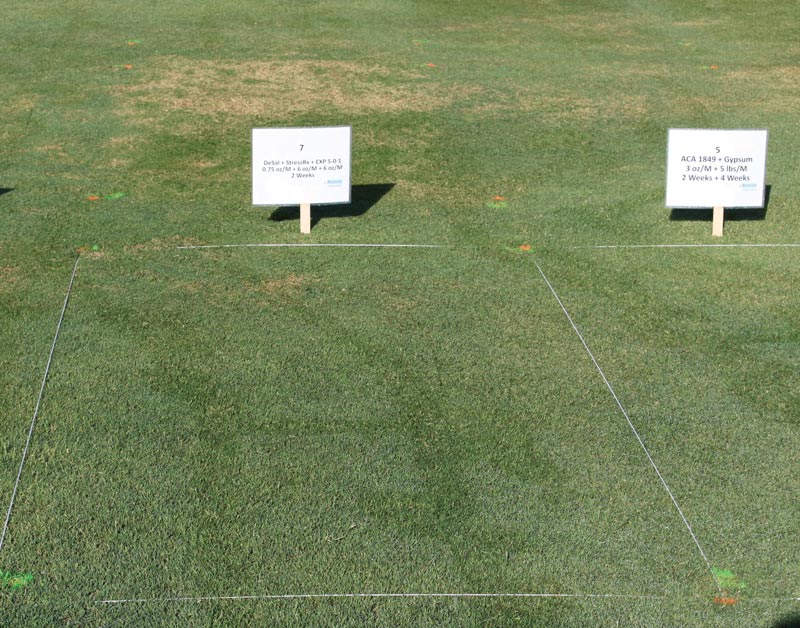
The salinity alleviation study area at the University of California, Riverside. Tifway II hybrid bermudagrass sod was installed in August 2012. Turf was irrigated with saline water from adjacent storage tanks, and commercial and experimental products were applied from April to October in 2013 and 2014. This photo was taken on Sept. 11, 2014. Photos by Marco Schiavon
Using saline or recycled water in combination with turfgrass species that have a high tolerance to salinity is a common strategy for reducing fresh water consumption. Recent estimates are that 13% of the golf courses in the United States use recycled water for irrigation (3). This percentage is higher in areas that are particularly affected by drought conditions. For example, using data from 2006, researchers estimated that more than one-third of golf courses in the southwestern United States irrigate with recycled water (4).
Factors that affect water quality include: concentration of soluble salts (electrical conductivity, or EC); relative proportion of sodium to other cations (sodium adsorption ratio, or SAR); and concentration of toxic elements (for example, boron). As plant roots take up water through osmosis (that is, water moves from a less concentrated solution to a more concentrated solution), excessive amounts of soluble salts can cause the plant to work harder to absorb water from soil, and symptoms of drought can be visible even though soil moisture is adequate.
In the past, leaching salts from the root zone was considered the most important management practice for alleviating salt stress (1). Leaching consists of applying supplemental water in addition to normal irrigation practices to help move salts below the root zone. Still, in the southwestern United States, incorporating a leaching fraction into regular irrigation management may be not possible for golf courses, especially when turf is actively growing. Because evapotranspiration (ET) rates are high during the hot summer months, irrigation run times may be too long to maintain playable course conditions.
Excessive sodium in irrigation water may lead to dispersion of soil particles and consequent deflocculation, especially in heavier clay soils, resulting in plugging of soil pores, decreased water infiltration and oxygen, and loss of rooting (2). The sodium adsorption ratio of irrigation water should be 6 or lower to avoid soil structural deterioration, but golf course superintendents in drier areas may often deal with higher levels of SAR.
Calcium dislocates sodium from exchange sites on soil colloids, preventing soil structure deterioration and deflocculation. Because of its low cost and accessibility, gypsum has historically been the most commonly used product to limit sodium hazards. Another strategy is the application of soil surfactants to increase soil wettability and eliminate soil water repellency. Surfactants allow water to penetrate hydrophobic root zones by altering surface water tension.
Several calcium-based products and wetting agents have been commercially available for salinity management, and overall, turf managers are inundated with a plethora of salinity alleviation products, many of which have not been tested under unbiased, replicated experiments on turf.
The objectives of this study were to compare several commercial and experimental programs for their ability to alleviate salinity stress on bermudagrass turf irrigated with saline water.
Materials and methods
The study was conducted in 2013 and 2014 at the University of California, Riverside turfgrass research facility. The research area was sodded with Tifway II hybrid bermudagrass on Aug. 6, 2012, on a Hanford fine sandy loam (70.4% sand, 19.8% silt, 9.8% clay, 6% organic matter). The turf was verticut once in August 2013 and again in June 2014 and received fertilizer each growing season for a total of 4 pounds nitrogen/1,000 square feet/year using polymer-coated urea fertilizer (46-0-0).
Turf was irrigated at 75% evapotranspiration with Toro 300 series pop-up stream sprinklers on 30-foot (9-meter) spacing. Saline water was made by mixing salts in potable water within two 5,000-gallon (18,900-liter) storage tanks (Snyder Industries) containing submersible pumps for mixing and agitation. Saline water ion composition was based on Colorado River water (D.L. Suarez, personal communication, 2012) and contained elevated concentrations of salts including sodium (Na+), chlorine (Cl−) and sulfate (SO42−), but not bicarbonate (HCO3−) and carbonate (CO32−) (Table 1). Saline water used to irrigate plots was classified as very high in salinity and sodium hazard (C4-S4) (5). Total salinity of the water was chosen to simulate an extreme but realistic irrigation salinity for turf in California (M. Huck, personal communication, 2012).
We tested 30 commercial and experimental products for their ability to alleviate salinity stress on bermudagrass. These treatments included calcium-based products as well as wetting agents and supplemental nitrogen fertilization and/or biostimulants (Table 2). Treatments were applied either once only, biweekly, monthly or bimonthly between April 4 and Oct. 17, 2013, and April 3 and Oct. 15, 2014.
Turf irrigation scheduling included irrigation immediately after application of treatments and again later in the evening. Saline irrigation was withheld during the winter months in 2013-2014 and restored in the spring. The combination of natural rainfall and cessation of saline irrigation during the winter of 2013-2014 lowered soil salinity in the study area and ensured there was no carryover from treatments applied in 2013.
Every two weeks and between treatment applications, plots were evaluated for turf quality on a scale of 1 to 9 (1 = worst; 9 = best) and for dark green color index (DGCI) using Digital Image Analysis (DIA). Leachate (3 replicates/treatment) was also collected and analyzed for electrical conductivity (ECL) on the same day. During rating weeks, irrigation scheduling included the night before collection of leachate samples. Composite or replicate (6/treatment) soil samples were collected and analyzed for salinity (ECe), sodium adsorption ratio and nutrients (AgSource Labs, Lincoln, Neb.) at the time of turf establishment in 2012, before initial treatment applications, and after final treatment applications in 2013 and 2014.
Results
The highest quality was recorded in plots treated with DeSal + Stress Rx + XP Extra Protection. In fact, this was the only treatment that resulted in higher quality than the untreated control for both years and acceptable quality of 6 or higher in 2014 (Figure 1).

Tifway II hybrid bermudagrass after two years of irrigation with saline water and treatment with DeSal + Stress Rx + XP Extra Protection. This photo was taken on Sept. 11, 2014.
Turfcare NPN also improved turf visual quality in comparison to the control. Dark Green Color Index was higher in comparison with the control among the same treatments that also showed higher turf quality (data not shown). Conversely, ACA 2994 caused bermudagrass discoloration, especially during the early stages of the 2014 experiment, and lower DGCI in comparison with the control (data not shown).
Although no differences were detected in 2013 (Table 3), soil samples collected at the end of 2014 showed that three treatments were able to lower salinity. ACA 1849 + gypsum, ACA 2994, and DeSal + Stress Rx + XP Extra Protection plots showed lower soil electrical conductivity, sodium adsorption ratio and sodium content in comparison with the control in 2014 (Table 4).
Of these three treatments, DeSal + Stress Rx + XP Extra Protection was the only one that also had a positive effect on turf quality. ACA 1849 and gypsum were effective only in combination, whereas neither had a positive effect when applied alone. The positive effect that DeSal + Stress Rx + XP Extra Protection had on bermudagrass was most likely due to beneficial effects on soil characteristics (Table 4) and the supplemental nutrition that the program provided to the turf.
Conclusions
In our study, although bermudagrass was not severely stressed and no turf loss was recorded over the two-year period, only one salinity alleviation program had the ability to maintain turf above an acceptable level of quality.
Calcium application has often been proposed as a strategy to alleviate sodium permeability hazard. However, in mostly sandy soils like ours, gypsum application may not be deemed necessary. Nevertheless, our results indicate that some programs can be successfully used to mitigate symptoms of salinity stress while also ameliorating soil conditions.
More research is needed to determine whether applying nitrogen at higher than recommended rates for fertilization on golf courses and other areas would be able to mask salinity stress while also sustaining turf health and playability.
Funding
The authors would like to thank the Metropolitan Water District of Southern California, United States Golf Association, California Turfgrass & Landscape Foundation, and the companies (Agribiotic Products, Aquatrols, EarthWorks, Gantec Inc., Grigg Brothers, Brandt Consolidated Inc., LH Organics, Mitchell Products, Numerator Technologies Inc., Ocean Organics and Westbridge Agricultural Products) that provided product and financial support for this research.
The research says ...
- We tested 30 commercial and experimental products for their ability to alleviate salinity stress on bermudagrass.
- The only product that had an effect on turfgrass quality and soil chemistry was DeSal + Stress Rx + XP Extra Protection.
- More research is needed to determine whether nitrogen applications above the recommended rates can mask salinity stress while sustaining turf health and playability.
Literature cited
- Ayers, R.S., and D.W. Westcot. 1985. Water quality for agriculture. FAO Irrigation and Drainage Paper 29 (Rev. 1). Food and Agriculture Organization (FAO) of the United Nations, Rome, Italy.
- Duncan, R.R., R.N. Carrow and M. Huck. 2000. Understanding water quality and guidelines to management: An overview of challenges for water usage on golf courses for the 21st century. USGA Green Section Record 38(5):14-24.
- Steinke, K., and E.H. Ervin. 2013. Turfgrass ecology. Pages 347-381. In: B. Horgan, J. Stier and S. Bonos, editors. Turfgrass: Biology, use, and management. Agronomy Monograph 56. ASA, CSSA and SSSA, Madison, Wis.
- Throssell, C.S., G.T. Lyman, M.E. Johnson, G.A. Stacey and C.D. Brown. 2009. Golf course environmental profile measures water use, source, cost, quality, and management and conservation strategies. Applied Turfgrass Science doi:10.1094/ATS-2009-0129-01-RS
- U.S. Salinity Laboratory. 1954. Diagnosis and improvement of saline and alkali soils. USDA Handbook 60. U.S. Government Printing Office, Washington, D.C.
Marco Schiavon is an assistant researcher in botany and plant sciences at the University of California, Riverside. This fall, he will join the University of Florida Institute of Food and Agricultural Sciences at the Fort Lauderdale Research and Education Center. James Baird is an associate specialist in Cooperative Extension and an associate horticulturist in botany and plant sciences at the University of California, Riverside.